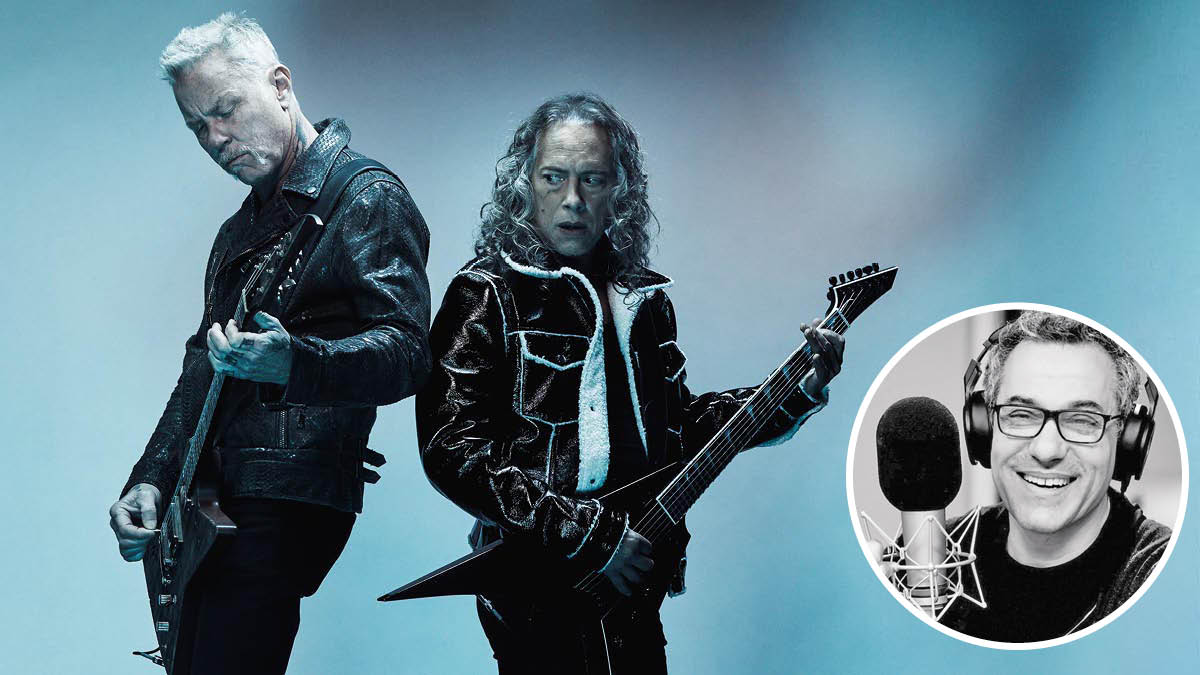The guitar gear secrets behind James Hetfield and Kirk Hammett’s tones on 72 Seasons
Metallica co-producer Greg Fidelman reveals how the new album was made with the help of a Marshall modded by Eddie Van Halen’s amp wizard and a rack full of battle-hardened guitars, including one that makes Hetfield “immediately want to play fast riffs”

Greg Fidelman first worked with Metallica as engineer on the 2008 album Death Magnetic – a result of his long association with that album’s producer Rick Rubin.
Since the late 90s, Greg has served as engineer on numerous albums produced by Rubin, including System Of A Down’s self-tilted debut, the Red Hot Chili Peppers’ Californication, the posthumous Johnny Cash release American V: A Hundred Highways and Black Sabbath’s final album 13.
It was on the 2011 album Lulu, Metallica’s collaboration with Lou Reed, that Greg took on the role of co-producer alongside guitarist James Hetfield and drummer Lars Ulrich. He has continued in this capacity on 2016’s Hardwired... To Self-Destruct, 2020’s live album S&M2 and now, this year’s 72 Seasons.
“It’s not your traditional hard rock record,” Greg says as he gives TG the inside story of its creation...
When you started making 72 Seasons, what conversations did you have about how you wanted it to sound?
“Initially everyone was isolated. We started trying to write songs remotely. So some of the usual chats you would have before walking into a project didn’t happen. It was more, ‘Do you think we could try to cobble together some riffs and some song ideas while we’re waiting this thing out?’
“Then we got together for a Helping Hands benefit broadcast from Metallica HQ. We thought, ‘Let’s show up a week early and stay a week after, and in person work on these songs that we had.’ Everyone was so excited to get started, and so excited to be playing together. We never really looked back.”
Get The Pick Newsletter
All the latest guitar news, interviews, lessons, reviews, deals and more, direct to your inbox!
Big parts of it are from the live take with all four of them playing at the same time. When it happened it was still like, ‘Oh my God, that feels great. We’ll never beat that!’
Was there a specific aim within the band of what direction this album would take?
“No-one felt there was a reason to stray very far away from what we had done on the previous record, Hardwired... To Self-Destruct. We definitely talked about more of trying to capture a live feel, because everybody was so energized by being in the same room and playing the stuff together. It’s not your traditional hard rock record where there’s a drum tracking session and then everything else is an overdub.
“Big parts of it are from the live take with all four of them playing at the same time. When it happened it was still like, ‘Oh my God, that feels great. We’ll never beat that!’ Maybe there’s a vocal overdub because at that time he hadn’t written all the lyrics, but trying to keep the live feel; that was in our playbook from the start.”
There’s more midrange and less gain on the guitars than some past Metallica albums. Were you using more British-style amps?
“James has always had one of the legendary José Arredondo-modded Marshalls, a late-’60s/early-’70s Superlead head. When we did Hardwired... it wasn’t working very well. When we started this album I had a re-invigorated interest in this head. I was talking with Dave Friedman, who is very familiar with those old José mods, and he fixed it. When I got it back, I told James I thought it sounded insane, and he got really excited about it. It ended up on every song. I think that’s what you’re hearing.”
What other guitar amps were in the mix?
“James has combinations of multiple amps and the balance between them changes from song to song. There’s always a Mesa/Boogie Mark IIC++ that he’s had forever, and then this José Marshall – at least a combination of those two.
“There’s also usually a Wizard 100-watt head that’s usually got a Klon Centaur pedal on it. He also has a Diezel head. When we need to find a bigger bottom end, especially on the slower songs, we can bring that in. It has huge low-end that the other amps don’t have.”
And Kirk?
“For Kirk, it’s different for solos and for rhythm [guitars]. For rhythms, Kirk had a couple of different Friedmans. Sometimes it was the HBE Deluxe and sometimes it was some early HBE head that Dave Friedman modded. We had a Marshall a 50-watt master volume JMP, I think a ’79, that just sounds amazing.
“For solos, we had a 100-watt master volume JMP that’s a little more gritty and scoopy, and we would combine that with a Mesa/Boogie Dual Rectifier. Kirk also had an old Kirk Hammett signature Randall head that has a really clear, defined midrange.
For rhythms, Kirk had a couple of different Friedmans. Sometimes it was the HBE Deluxe and sometimes it was some early HBE head that Dave Friedman modded
“That was always nice to add to the mix so it could be super-overdriven but not blurry and fizzy – you can still hear the notes. We’ve got hundreds of cabinets over there but James almost always ends up on similar – the Mesa/Boogie and Marshalls go into old Marshall cabinets, and the Diezel I think goes through Mesa cabinets. Similar stuff for Kirk: a mixture of older Marshall cabinets with either 30- or 25-watt Celestions.
“For solos, usually we’ve got a cabinet or two with 75-watt Celestions, and there’s a Mesa cabinet labelled Black Shadow. I think they might be Eminence speakers, probably from the mid-’80s, but those also sound really good.”
What guitars were they using?
“Kirk used Greeny and his original Mummy guitar. He’s got a hundred ESPs that look like the Mummy. I don’t know what it is about that one in particular, but it noticeably sounds a little different than all the other ones, and it’s just great. James has his Flying V that he had from Kill ’Em All. It’s a Gibson copy, but that thing sounds incredible.
“When he puts that guitar in his hands he immediately wants to play fast riffs. So if it’s a fast song, for sure it’s got that on it. He double-tracked all of [his] stuff; sometimes triple-tracks. We usually double with the ESP Explorer with the middle-finger inlays. I think it’s the first ESP that he got – that guitar sounds incredible.
“Then he’s got one of his signature model Snakebytes that is a strange copper colour. We’ve tried 15 or 20 different Snakebyte guitars, and this one just was a little bit nicer for whatever reason. The majority is the V or the Snakebyte combined with the ESP Explorer on the double track. On a couple of the mid-tempo to more slow songs he used a Les Paul.”

A few songs have kind of a ‘Black Album’ vibe. Was that a conscious decision?
“I don’t think it was, but when we were putting songs together, it’s almost subconscious to want all these different styles. You want to have some fast-ripping, thrashy songs, and some mid-tempo Creeping Death thing that’s not super fast but it’s not slow grooving ‘Black Album’ either.
“Then you want to have a Sad But True – that’s the classic reference in from my head anyways for Metallica being slow but heavy. We didn’t write songs to fit any of those categories as much as we had a bunch of ideas, like, ‘We’ve got four or five big, heavy, slow riffs, and there’s one no one’s that excited about but everyone loves these others. Maybe we should work on these.’”
There are definitely songs with ‘the Sabbath riff’. It’s not a Sabbath riff, but when they’re playing it, this is like what I remember Black Sabbath being like when I was 13
Do you use classic Metallica tracks as references for writing or arrangements?
“I guess for arrangements. On the song Too Far Gone, there was a section that when we first started working on it we would call the ‘Leper’ section because something about it reminded James of Leper Messiah [from Master Of Puppets]. We have those kinds of references, a language instead of calling everything ‘verse’, ‘chorus’ or ‘bridge’.
“It’s not just Metallica references, either. There are definitely songs with ‘the Sabbath riff’. It’s not a Sabbath riff, but when they’re playing it, this is like what I remember Black Sabbath being like when I was 13.”
Parts of Inamorata have a real Sabbath vibe.
“Yeah, I think Inamorata is in C# or some very bizarre key. It was a riff from the tuning room when they were warming up before a show. I don’t know why James was in C# when he was coming up with it. When we started working on it we said: ‘This is a weird key. Maybe should try this in A or in E?’ But for some reason that’s just not as cool.
“You’d think, ‘Let’s put it lower, it’ll sound even heavier.’ But it was the opposite. When we tried it in more common keys, everyone was like, ‘Now I don’t like it so much!’ So we embraced that challenge of writing a heavy song in C#. You don’t really have a lot of open strings as an option in that key, so it was to come up with some ideas that we may not have otherwise come up with.”
I think it’s well-known that Lars likes to be involved in solos, and he and Kirk work together in a unique way
What direction did you give Kirk on his soloing?
“I think it’s well-known that Lars likes to be involved in solos, and they work together in a unique way. I’m sort of a third partner in that. Kirk comes in improvising most of the stuff, but when we’re recording or rehearsing the songs, every now and then something that would go by that someone would say, ‘Hey, could you mark that for later?’
“So when it came time to actually record solos we always had that stuff ready to go. A lot of the songs had a bunch of things that we thought were cool as a springboard, although they were improvised initially. We would listen back to all these and start being like, ‘Oh that that’s a cool place to go there, that’s a good entrance, that’s a great ending.’ So he improvised to get the feel and ideas, but then we would have a plan.”
This feels like the most cohesive Metallica album for a long time. How did you achieve that?
“We talked about making it a collaborative effort, more than the last couple of records. [We wanted] all four guys to be more involved, to act together at the same time as opposed to working on it separately. That’s a goal we set and one I feel confident we hit. We had the guys in the same room as much as possible when we were writing and tracking this record, and everyone’s getting their two cents in. It’s a better record because of it.”
- 72 Seasons is out now on Rhino/Blackened Recordings.
Jenna writes for Total Guitar and Guitar World, and is the former classic rock columnist for Guitar Techniques. She studied with Guthrie Govan at BIMM, and has taught guitar for 15 years. She's toured in 10 countries and played on a Top 10 album (in Sweden).
“His songs are timeless, you can’t tell if they were written in the 1400s or now”: Michael Hurley, guitarist and singer/songwriter known as the ‘Godfather of freak folk,’ dies at 83
“The future is pretty bright”: Norman's Rare Guitars has unearthed another future blues great – and the 15-year-old guitar star has already jammed with Michael Lemmo















